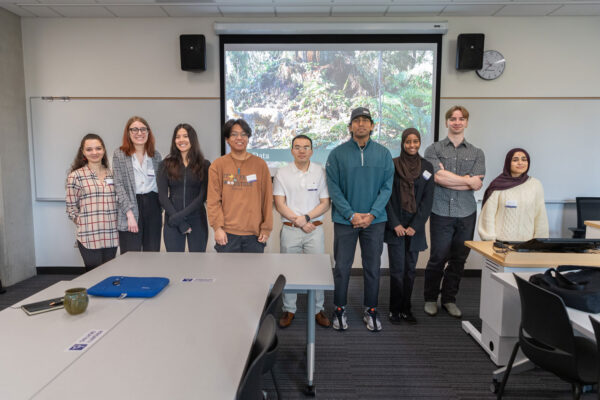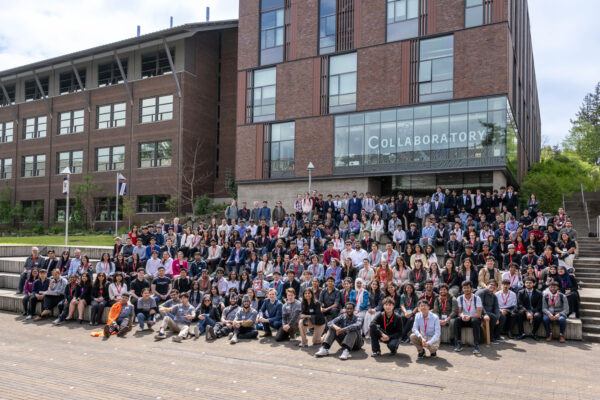Early in his career as an ecologist, Dr. David Stokes, like many at the time, wanted to understand how ecosystems functioned in pristine conditions away from human influence. In Patagonia, South America, he studied penguins to get the “unvarnished truth” about nature.
Later, he began to feel like another piece was missing from the puzzle — the human piece.
“By the time I came to Bothell, I was becoming more convinced that humans are a really important part of the story,” said Stokes, a professor in the University of Washington Bothell’s School of Interdisciplinary Arts & Sciences.
Stokes began teaching at the University in 2006 and was quickly drawn to nearby Saint Edward State Park as a potential site for research and learning opportunities for students. “I was really interested in how natural systems work in an urban context, and Saint Edward State Park was a great example of that,” Stokes said. “It’s a really spectacular natural resource that we have right in our backyard that is so accessible to campus.”
Together with other faculty, staff and partners in the community, Stokes helped to push forward a project for a newcfacility at the park. In 2022, the Environmental Education and Research Center opened as a place for the appreciation, research, study and stewardship of Pacific Northwest ecosystems.
In winter 2024 quarter, Stokes taught the first UW Bothell course based out of the center.
Where humans and nature meet
Students in Stokes’ course, Investigative Biology, begin to learn the research process and get to identify areas of research interest to pursue throughout the quarter. Taking advantage of the location, Stokes asked students to focus on an ecological aspect of the park, with an emphasis on topics that could have a conservation impact.

From beginning to end, students were responsible for each step of their research projects — from data collection and analysis to reporting out on their findings at the winter 2024 Undergraduate Capstone & Symposium.
Saint Edward State Park is one of the most visited parks in Washington, with substantial foot traffic on its trails and other recreational areas. Curious about the impacts trails have on the park’s inhabitants, one student group did its research on “Exploring Wildlife Presence and Activity in Response to Recreational Trail Impact.”
“Saint Edward has a massive physical visitation rate that has gone up since the COVID-19 pandemic, with more than 800,000 people last year,” Stokes said. “That’s great. We want people to enjoy nature, and parks are increasingly the main way people experience it in this hub setting. But what are the effects on animals?”
Another group studied the effects humans can have in a project called “Investigating the Impact of Road Proximity and Traffic Volume on Wildlife Activity and Behavior.”
Both student groups used cameras to collect data about the wildlife that live in or pass through the park — and documented some correlation between the amount and variety of wildlife and the proximity to park trails and roads.
A closer look at canines
Students in the class looked not just at direct human impact but also at another type of park visitor: canine pets. Students doing a “Dogs in an Urban Wildland” research project were curious to find out how many people brought dogs into the park, as well as how many dogs were being let off-leash to roam.
“Research on wildlife in urban green spaces is limited but vital to helping to preserve as much of the natural world as possible and as we humans continue to urbanize,” said Alyssa Alridge, a senior majoring in Biology and minoring in Health Studies and in Neuroscience. “I thought it was important to look at impacts of domestic dogs because people tend to forget that while they are animals, we have bred them to the point that they aren’t wildlife anymore.”
In reviewing footage from the wildlife cameras, the student team noted some behavioral changes. Certain prey species took longer to appear after an unaccompanied, off-leash dog had entered a space, perhaps as a cautionary response to the threat dogs pose.
“After the COVID-19 outbreak, more people began to enter the park, likely to feel less ‘trapped’ by their homes. At the same time, there was a spike in people getting pets,” Alridge said, adding that while a higher percentage of people appeared to keep their dogs on a leash than was recorded in previous years, the increasing number of dogs overall also meant that there were more instances of off-leash dogs than in previous years.
“The real-world application of this research,” Alridge said, “is that we can put more concrete and regulated rules on domestic pets brought into spaces with wild animals and the proper actions needed to do as little harm as possible.”

The value of diverse habitats
In his group’s research, John Ryu Bargayo assessed the habitat value of dead logs in the forest’s ecosystem.
“I chose this particular project because I’ve always had an interest in micro habitats and dead logs were a cool way to look at that,” said Ryu Bargayo, a senior majoring in Biology. “Our research has urban green space applications and implications on how to better the urbanized society we live in now where biodiversity is low.”
While the importance of downed logs in forests and wildlands is well known and studied, Stokes said, less research has been done on whether this habitat is equally valued by wildlife in urban green spaces.
The team placed cameras on park sites with dead logs and those without. The students then analyzed the footage, looking for differences in the number and diversity of species using the areas. They found that habitats with dead logs had more mammals present compared to those without. Eastern gray squirrels were particularly abundant in the habitats with dead logs.
“I’ve always wanted to get into field research and study animal ecology,” Ryu Bargayo said. “I would like to do animal research in the future, so it was a good opportunity for me. The EERC being a prime location within Saint Edward State Park added to the feel of being a researcher and in a field of interest.”
I would like to do animal research in the future, so it was a good opportunity for me. The EERC being a prime location within Saint Edward State Park added to the feel of being a researcher and in a field of interest.
John Ryu Bargayo, senior, Biology
A future of access
Doing a research project such as these from start to finish in the span of only a quarter is no easy feat, Stokes said. It’s a big lift, and he was impressed by the students’ results.
“There’s an on-the-ground significance and potential to their work,” he said. “Each of these projects has a potential application to the conservation of biodiversity. They’ve really risen to the challenge.”
For the students, having class located right next to their research sites was a boon to the experience.
“I was excited to take a class observing wildlife behavior in urban green spaces. Being within the park we were focusing our study on, I felt more connected to it that way,” Alridge said. “I am looking forward to seeing what other students and Dr. Stokes learn about and observe at Saint Edward State Park in the future.”



